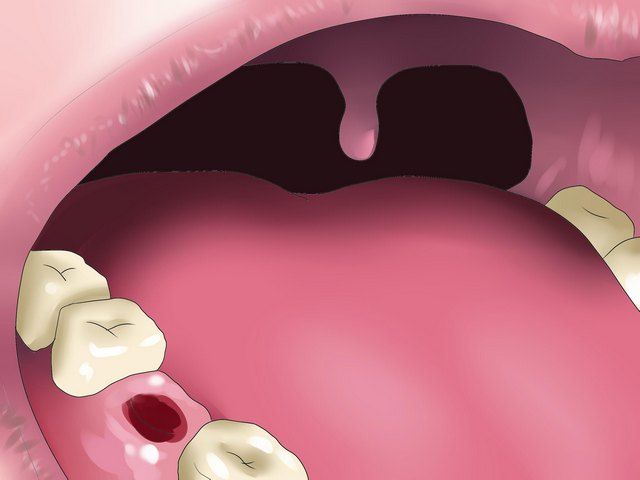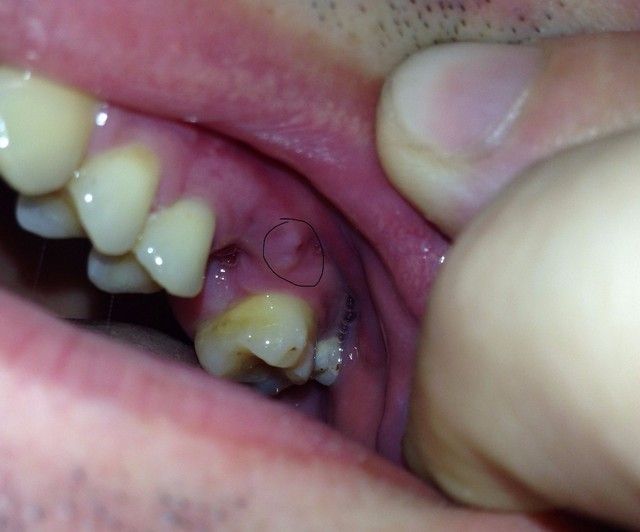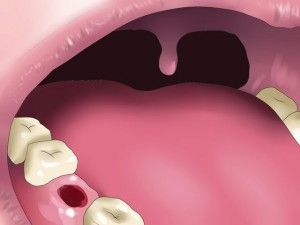Sometimes, due to poor-quality tooth extraction, the remainder of the tooth may remain in the gum, or as it is also popularly called the periosteum. In different cases, the bone left after can make itself felt in different ways. In some people, the bone can play the role of a common cosmetic defect and not cause much discomfort to its owner. In other people, the rest of the tooth will become inflamed and may begin to rot, in which case it can bring a lot of trouble and discomfort to its owner, so it is best to get rid of it as soon as possible.
There is also a third scenario - after the tooth is removed, a small periosteum will stick out of the gum, as a rule it will be almost imperceptible and therefore it will also be too problematic to remove. Even though the residue is almost invisible to the naked eye, it is still very dangerous, since at any moment it can make itself felt with inflammation of the gums.
Causes
So, if after the extraction of a tooth a bone unexpectedly crawled out, what could be the reasons? The main cause of this problem is the poor-quality removal of one or more molars. Sometimes, immediately after the operation, it is impossible to see the remains of the old tooth, as they are hidden behind the inflamed gums after severe stress. They can only be detected when the pain at the site of the old tooth (teeth) subsides and the inflammation subsides a little, that is, after 2-6 hours (possibly later).
As a rule, such remnants of the tooth make themselves felt, since the pain and inflammation in the gums do not go away for too long after the extraction. In this case, you should immediately contact your doctor. What can threaten you with the bone remaining on the gum after tooth extraction? If the place where the tooth was previously located has been hurting for more than a week, then at best the fragment interferes with the healing of the wound, and at worst the process of gum decay has already begun. Without the help of a specialist, at best, your gums will hurt for several more weeks, at worst, a serious complication and gangrene are possible.
There is also a less painful variation of this disease. Suppose you have a molar tooth removed, but after the removal, a small part of the root remains in the gum. With a certain location, a small residue may not cause any pain or discomfort, and may also be almost invisible. In this case, many people, after finding a small remnant of the former tooth, do nothing, since it does not bother them in any way. However, in vain. It is best to contact your healthcare provider as soon as you have found a potential bone with your tongue and request that the gum be examined for potentially dangerous root debris and removed immediately.
However, it happens that even after the extraction of a tooth, there are no remnants of it left, but after some time after the extraction of the tooth, the bone comes out. In this case, you are not worried about the fragments of your former tooth, but the bone that has come out of the gum. A bone can come out if:

What can a bone grown from the gums threaten? In fact, little more than good oral care. If a small bone sticks out of the gum, in the place where the molar used to be, then contact your doctor for advice.
Provided that the periosteum appeared due to a slight displacement of the gums, then you have nothing to be afraid of, since it is not a fragment and, with good dental care, will not begin to rot.
However, if it brings you discomfort, then when contacting a specialist, this defect can be easily corrected.
Also, in an extremely small number of people, after the molar tooth is removed, a new one may begin to climb, but this is extremely rare. Most often, the new tooth is not fully formed and looks like a small and underdeveloped tooth, which undoubtedly spoils the smile. If the owner wishes, an under-formed tooth can be easily and almost painlessly removed, since most of them have poorly developed nerve endings. Sometimes the removal of such teeth is simply necessary, as serious complications may appear over time.
How to get rid
![]() As already mentioned above, in some cases, you can not get rid of the bone sticking out of the gum. However, if this defect is found in all cases, it is best to contact your doctor, as he will definitely advise you on what to do with this ailment. You can also insist on removing the bone or fragment that is interfering with you. But if, according to the attending physician, the removal of the periosteum is not necessary, then you will have to pay extra, otherwise the protruding bone will not be removed in the free clinic. However, your request to remove a harmless bone will need to be somehow argued, for example, the bone causes some inconvenience in the oral cavity and / or looks ugly.
As already mentioned above, in some cases, you can not get rid of the bone sticking out of the gum. However, if this defect is found in all cases, it is best to contact your doctor, as he will definitely advise you on what to do with this ailment. You can also insist on removing the bone or fragment that is interfering with you. But if, according to the attending physician, the removal of the periosteum is not necessary, then you will have to pay extra, otherwise the protruding bone will not be removed in the free clinic. However, your request to remove a harmless bone will need to be somehow argued, for example, the bone causes some inconvenience in the oral cavity and / or looks ugly.
If, according to you, fragments from a tooth or an overgrown bone cause you severe discomfort and pain, then your dentist must carefully examine your oral cavity for inflammation or decay. If you find or suspect that you have these symptoms, the dentist must do something. As a rule, the actions of the doctor will be as follows:
- If an examination of your teeth shows that you have inflammation and / or decay, or the possibility of such, then the dentist is obliged to remove the remnants free of charge (if you are in a free clinic), or else “set” your displaced jawbone.
- If for some reason it is impossible to do all the above procedures, your attending physician is obliged to give you a referral to the hospital where these procedures are not difficult to do.
- After the remnants of the roots of the old tooth or the bone have been set, you will be prescribed various antiviral and anti-inflammatory drugs, and it will also be recommended to better monitor oral hygiene so that complications do not appear over time.
 Removal of tooth residues can sometimes take place without anesthesia, but most often, in order not to cause unnecessary stress to the patient, the entire procedure is done under local anesthesia. If your jawbone (periosteum) has been slightly erupted due to displacement, then it can be easily “reset”, as a rule, this procedure is not too painful and does not require good anesthesia. However, a person who knows his business should “set” the jaw, otherwise your doctor will only make you worse. Sometimes it happens that it is not possible to remove all the remnants from the root of the old tooth at a time, in which case you will be prescribed an anesthetic, as you will have to endure pain in the place of the old tooth until the next appointment with the doctor.
Removal of tooth residues can sometimes take place without anesthesia, but most often, in order not to cause unnecessary stress to the patient, the entire procedure is done under local anesthesia. If your jawbone (periosteum) has been slightly erupted due to displacement, then it can be easily “reset”, as a rule, this procedure is not too painful and does not require good anesthesia. However, a person who knows his business should “set” the jaw, otherwise your doctor will only make you worse. Sometimes it happens that it is not possible to remove all the remnants from the root of the old tooth at a time, in which case you will be prescribed an anesthetic, as you will have to endure pain in the place of the old tooth until the next appointment with the doctor.
If everything went well for you, then it’s not time to relax. Be sure to strictly follow your doctor's recommendations, take all your prescribed anti-inflammatory and antiviral drugs, and brush your teeth after every meal. It is possible that your doctor will forbid you to eat solid food for some time after the operation, but even if such a ban is not given, it is best to refrain from eating solid food for a day. Also try not to get sick in the near future, as the appearance of viruses in your body can adversely affect the healing of the gums, and if you get sick, then try not to disturb the wound that has not yet healed or has recently healed.
 Perhaps, for some reason, you want to remove the periosteum yourself, although this is strongly discouraged. Before you self-medicate, you need to learn more about your problem, you can use the Internet, but it is best to contact a specialist directly for advice.
Perhaps, for some reason, you want to remove the periosteum yourself, although this is strongly discouraged. Before you self-medicate, you need to learn more about your problem, you can use the Internet, but it is best to contact a specialist directly for advice.
Then you can proceed with self-deletion (do this at your own peril and risk). The first method of removal is quite simple - you must pull out the bone yourself, but you need to do this with sterile tools and clean hands so as not to bring yourself any infection. You can also, on the recommendation of a specialist, buy a special one, which will need to rub the periosteum until it can be easily pulled out on its own.
If you have the opportunity to choose a clinic where you can extract teeth, then it is best to give preference to a paid option, since the quality of the services provided there is higher than in free clinics. However, it is best to look for other people's reviews on the Internet about a particular clinic, if the clinic has experience in dental operations, then there should be reviews about it.
Regardless of the quality of the extraction of molars, you have a risk that a periosteum will appear after a few days or months. Most often, the removal of the periosteum is quick and without particularly severe pain.
If you do not want to remove the periosteum surgically, then consult with your doctor about the possibility of an alternative option. Most likely, your doctor will suggest that you buy a special dental cream, thanks to which the periosteum will come out on its own after a few days of use.





